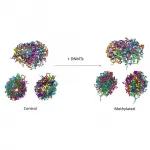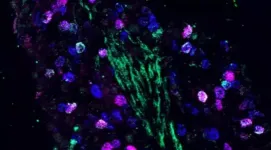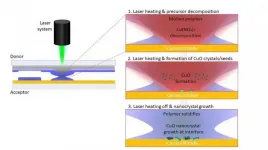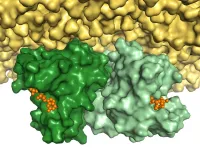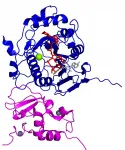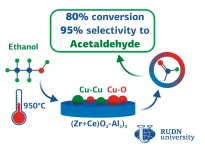INFORMATION:
Note
The Bering Land Bridge was located on the place of the modern Bering Strait, separating the extreme northwest of America and the extreme northeast of Asia. The physical and geographical region of Beringia stretched from the Lena River in Russia to the Mackenzie River in Canada. It consisted of both land and sea components. The land area of Beringia changed during the Pleistocene (from 2.6 million years to 11.7 thousand years ago) along with the size of continental ice and its effect on sea level.
Researchers figured out how the ancestors of modern horses migrated
Molecular biologists studied the DNA of ones that migrated from North America to Eurasia and back
2021-06-02
(Press-News.org) An international research team determined that ancestors of modern domestic horses and the Przewalski horse moved from the territory of Eurasia (Russian Urals, Siberia, Chukotka, and eastern China) to North America (Yukon, Alaska, continental USA) from one continent on another at least twice. It happened during the Late Pleistocene (2.5 million years ago - 11.7 thousand years ago). The analysis results are published in the journal. The findings and description of horse genomes are published in the journal Molecular Ecology.
"We found out that the Beringian Land Bridge, or the area known as Beringia, influenced genetic diversity within horses and beyond," said senior researcher at the Ural Branch of the Russian Academy of Sciences and the Ural Federal University (Russia) Dmitry Gimranov. "Owing to the appearance of this land part, the flow of genes among mammoths, bison, and wolves could occur regularly. And if 1-0.8 million years ago horses from North America were not yet widespread in Eurasia, then in the periods of 950-450 and 200-50 thousand years ago, there was a bidirectional spread of genes over long distances."
In other words, horses migrated between continents not only in one direction but also vice versa. The first wave of migration was predominantly from North America to Eurasia. The second migration was dominated by the movement from Eurasia to North America.
The most important researchers conclude that most animals used the Beringian Land Bridge only once, and horses several times. This fact could significantly affect the genetic structure of horse populations and made them very interesting objects of research for paleogeneticists.
To determine the area of settlement of horses, molecular biologists studied horses' DNA from both continents. From 262 samples of bones and teeth, they selected 78 with sufficient DNA. Researchers conducted radiocarbon dating and genetic analysis at the Denmark and USA laboratories. In addition, they looked at the research data from 112 samples.
"The data shows that horses returned to North America from Eurasia across Beringia at about the same time as bison, brown bears, and lions," says Dmitry Gimranov. "That is, in the last "days" of the late Pleistocene, when the territory was not covered by water and it was like a bridge for the movement of many groups of animals. With the beginning of climate warming (the beginning of the Holocene or 11.7 thousand years ago) and the last disappearance of Beringia at the end of the Pleistocene, the biogeographic significance of this ecological corridor radically changed the history of terrestrial animal species on both continents."
Although the North American horse population eventually became extinct in the early Holocene, horses became widespread on both continents due to domestication and are now found far beyond their historical range.
ELSE PRESS RELEASES FROM THIS DATE:
Regulation of the genome affects its 3D structure
2021-06-02
All the cells of an organism share the same DNA sequence, but their functions, shapes or even lifespans vary greatly. This happens because each cell "reads" different chapters of the genome, thus producing alternative sets of proteins and embarking on different paths. Epigenetic regulation--DNA methylation is one of the most common mechanisms--is responsible for the activation or inactivation of a given gene in a specific cell, defining a secondary cell-specific genetic code.
Researchers led by Dr. Modesto Orozco, head of the Molecular Modelling and Bioinformatics lab at IRB Barcelona, have described how methylation has a protein-independent regulatory role by increasing the stiffness of DNA, which affects the 3D structure ...
Autistic people find it harder to identify anger in facial expressions -- new study
2021-06-02
Autistic people's ability to accurately identify facial expressions is affected by the speed at which the expression is produced and its intensity, according to new research at the University of Birmingham.
In particular, autistic people tend to be less able to accurately identify anger from facial expressions produced at a normal 'real world' speed. The researchers also found that for people with a related disorder, alexithymia, all expressions appeared more intensely emotional.
The question of how people with autism recognise and relate to emotional expression has been debated by scientists for more than three decades and it's only in the past 10 years ...
Gut to brain: Nerve cells detect what we eat
2021-06-02
The gut and the brain communicate with each other in order to adapt satiety and blood sugar levels during food consumption. The vagus nerve is an important communicator between these two organs. Researchers from the Max Planck Institute for Metabolism Research in Cologne, the Cluster of Excellence for Ageing Research CECAD at the University of Cologne and the University Hospital Cologne now took a closer look at the functions of the different nerve cells in the control centre of the vagus nerve, and discovered something very surprising: although the nerve cells are located in the same control center, they innervate different regions of the gut and also differentially control satiety and blood sugar levels. This discovery could play an important role in the development of future ...
Nanomaterials with laser printing
2021-06-02
In the journal Nature Communications, an interdisciplinary team from the Max Planck Institute of Colloids and Interfaces presents for the first time a laser-driven technology that enables them to create nanoparticles such as copper, cobalt and nickel oxides. At the usual printing speed, photoelectrodes are produced in this way, for example, for a wide range of applications such as the generation of green hydrogen.
Previous methods produce such nanomaterials only with high energy input in classical reaction vessels and in many hours. With the laser-driven technology developed at the institute, the scientists can deposit small amounts of material on a surface and simultaneously perform chemical synthesis in a very short time using high temperatures from the laser. 'When I discovered ...
Understanding feelings: When less is more
2021-06-02
A facial expression or the sound of a voice can say a lot about a person's emotional state; and how much they reveal depends on the intensity of the feeling. But is it really true that the stronger an emotion, the more intelligible it is? An international research team comprised of scientists from the Max Planck Institute for Empirical Aesthetics, New York University, and the Max Planck NYU Center for Language, Music, and Emotion (CLaME) has now discovered a paradoxical relationship between the intensity of emotional expressions and how they are perceived.
Emotions ...
Cancer-promoting Ras protein exists in a pair within cells
2021-06-02
Researchers from Bochum and Osnabrück have gained new insights into the structure of the Ras protein, which acts as a molecular switch for cell growth and is involved in the development of cancer. With the help of fluorescence markings, they have demonstrated that the protein is deposited in a pair at the cell membrane, and with the very structure that they predicted in theory back in 2012. The team from the Bochum Center for Protein Diagnostics (PRODI) hopes that these findings will open up a new approach for the development of cancer medications. The researchers from Ruhr-Universität Bochum (RUB) and Osnabrück University ...
Want to Talk About Prenups? Describe Them as Something Else
2021-06-02
Prenuptial agreements, or "prenups," can be difficult to talk about. But a recent study offers insights into how people can discuss this often taboo subject. One approach? Use metaphors.
"Many people view prenups as being negative, and argue that they indicate a lack of faith in the marriage from the outset," says Lynsey Romo, corresponding author of the study and an associate professor of communication at North Carolina State University. "By the same token, we know from other research that open communication about financial issues contributes to successful relationships.
"And yet there is virtually no academic research on prenups. So how do people talk about prenups? How do they make sense of them? That's what we wanted ...
Metal ions help COVID-19 virus to disguise itself
2021-06-02
SAN ANTONIO (June 2, 2021) -- Scientists from The University of Texas Health Science Center at San Antonio have discovered a mechanism by which SARS-CoV-2 exploits changes in metal ion concentrations to disguise itself in the body. Varying concentrations of metal ions -- positively charged atoms such as magnesium, manganese and calcium -- are observed in hospitalized COVID-19 patients.
"This is a newly described metal-dependent mechanism by which these ions help the virus to evade immune surveillance," said END ...
RUDN University chemists created cheap catalysts for ethanol conversion
2021-06-02
RUDN University chemists proposed a new way to synthesize catalysts for the conversion of ethyl alcohol. The obtained materials are promising catalysts for the selective conversion of ethanol, which is an important stage in the development of an alternative technology for obtaining valuable chemical synthesis products based on plant raw materials. The results of the study are published in Catalysis Today.
Ethanol fuel is ethyl alcohol, it is produced from plant material by fermentation of industrial or agricultural waste biomass. It is used as a more environmentally ...
Laser physics: Two-stage particle-beam booster
2021-06-02
In collaborative international effort, laser physicists at LMU have built the first hybrid plasma accelerator.
Particle accelerators have made crucial contributions to some of the most spectacular scientific discoveries of modern times, and greatly augmented our knowledge of the structure of matter. Now a team of laser physicists led by Prof. Stefan Karsch at the Ludwig-Maximilian University (LMU) in Munich and the Max Planck Institute for Quantum Optics, in cooperation with scientists based at the Helmholtz Centre in Dresden-Rossendorf (HZDR), the Laboratoire d'Optique Appliquée in Paris (LOA), Strathclyde University in Glasgow and the DESY Electron Synchrotron in Hamburg, have now achieved a significant ...
LAST 30 PRESS RELEASES:
This new understanding of T cell receptors may improve cancer immunotherapies
A new fossil face sheds light on early migrations of ancient human ancestor
A new immunotherapy approach could work for many types of cancer
A new way to diagnose deadly lung infections and save lives
40 percent of MRI signals do not correspond to actual brain activity
How brain-inspired algorithms could drive down AI energy costs
Gum disease may be linked to plaque buildup in arteries, higher risk of major CVD events
Contrails are a major driver of aviation’s climate impact
Structure of dopamine-releasing neurons relates to the type of circuits they form for smell-processing
Reducing social isolation protects the brain in later life
Keeping the heart healthy increases longevity even after cancer
Young adults commonly mix cannabis with nicotine and tobacco
Comprehensive review illuminates tau protein's dual nature in brain health, disease, and emerging psychiatric connections
Book prepares K-12 leaders for the next public health crisis
Storms in the Southern Ocean mitigates global warming
Seals on the move: Research reveals key data for offshore development and international ecology
Sports injuries sustained during your period might be more severe
World's first successful 2 Tbit/s free-space optical communication using small optical terminals mountable on satellites and HAPS
Can intimate relationships affect your heart? New study says ‘yes’
Scalable and healable gradient textiles for multi‑scenario radiative cooling via bicomponent blow spinning
Research shows informed traders never let a good climate crisis go to waste
Intelligent XGBoost framework enhances asphalt pavement skid resistance assessment
Dual-function biomaterials for postoperative osteosarcoma: Tumor suppression and bone regeneration
New framework reveals where transport emissions concentrate in Singapore
NTP-enhanced lattice oxygen activation in Ce-Co catalysts for low-temperature soot combustion
Synergistic interface engineering in Cu-Zn-Ce catalysts for efficient CO2 hydrogenation to methanol
COVID-19 leaves a lasting mark on the human brain
Scientists use ultrasound to soften and treat cancer tumors without damaging healthy tissue
Community swimming program for Black youth boosts skills, sense of belonging, study finds
Specific depressive symptoms in midlife linked to increased dementia risk
[Press-News.org] Researchers figured out how the ancestors of modern horses migratedMolecular biologists studied the DNA of ones that migrated from North America to Eurasia and back

